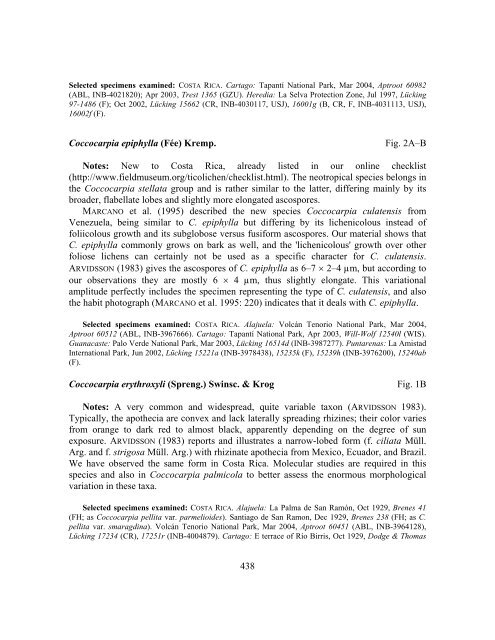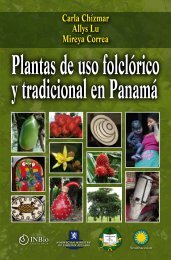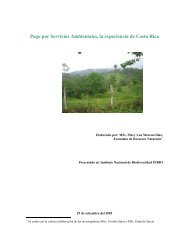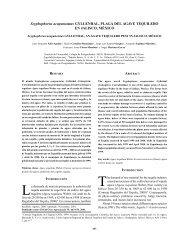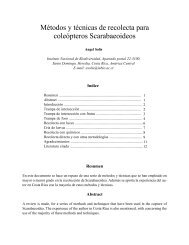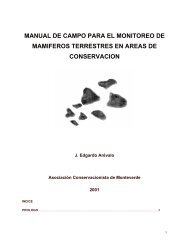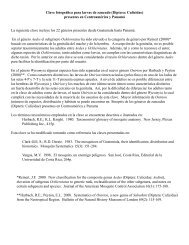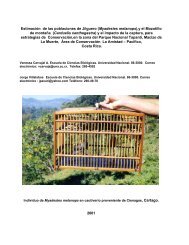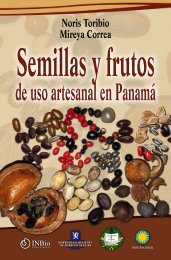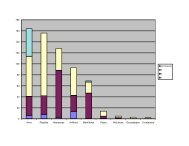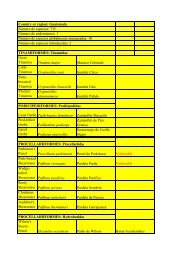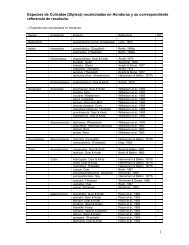the genus Coccocarpia (Peltigerales: Coccocarpiaceae) - Instituto ...
the genus Coccocarpia (Peltigerales: Coccocarpiaceae) - Instituto ...
the genus Coccocarpia (Peltigerales: Coccocarpiaceae) - Instituto ...
You also want an ePaper? Increase the reach of your titles
YUMPU automatically turns print PDFs into web optimized ePapers that Google loves.
Selected specimens examined: COSTA RICA. Cartago: Tapantí National Park, Mar 2004, Aptroot 60982<br />
(ABL, INB-4021820); Apr 2003, Trest 1365 (GZU). Heredia: La Selva Protection Zone, Jul 1997, Lücking<br />
97-1486 (F); Oct 2002, Lücking 15662 (CR, INB-4030117, USJ), 16001g (B, CR, F, INB-4031113, USJ),<br />
16002f (F).<br />
<strong>Coccocarpia</strong> epiphylla (Fée) Kremp. Fig. 2A–B<br />
Notes: New to Costa Rica, already listed in our online checklist<br />
(http://www.fieldmuseum.org/ticolichen/checklist.html). The neotropical species belongs in<br />
<strong>the</strong> <strong>Coccocarpia</strong> stellata group and is ra<strong>the</strong>r similar to <strong>the</strong> latter, differing mainly by its<br />
broader, flabellate lobes and slightly more elongated ascospores.<br />
MARCANO et al. (1995) described <strong>the</strong> new species <strong>Coccocarpia</strong> culatensis from<br />
Venezuela, being similar to C. epiphylla but differing by its lichenicolous instead of<br />
foliicolous growth and its subglobose versus fusiform ascospores. Our material shows that<br />
C. epiphylla commonly grows on bark as well, and <strong>the</strong> 'lichenicolous' growth over o<strong>the</strong>r<br />
foliose lichens can certainly not be used as a specific character for C. culatensis.<br />
ARVIDSSON (1983) gives <strong>the</strong> ascospores of C. epiphylla as 6–7 × 2–4 µm, but according to<br />
our observations <strong>the</strong>y are mostly 6 × 4 µm, thus slightly elongate. This variational<br />
amplitude perfectly includes <strong>the</strong> specimen representing <strong>the</strong> type of C. culatensis, and also<br />
<strong>the</strong> habit photograph (MARCANO et al. 1995: 220) indicates that it deals with C. epiphylla.<br />
Selected specimens examined: COSTA RICA. Alajuela: Volcán Tenorio National Park, Mar 2004,<br />
Aptroot 60512 (ABL, INB-3967666). Cartago: Tapantí National Park, Apr 2003, Will-Wolf 12540l (WIS).<br />
Guanacaste: Palo Verde National Park, Mar 2003, Lücking 16514d (INB-3987277). Puntarenas: La Amistad<br />
International Park, Jun 2002, Lücking 15221a (INB-3978438), 15235k (F), 15239h (INB-3976200), 15240ab<br />
(F).<br />
<strong>Coccocarpia</strong> erythroxyli (Spreng.) Swinsc. & Krog Fig. 1B<br />
Notes: A very common and widespread, quite variable taxon (ARVIDSSON 1983).<br />
Typically, <strong>the</strong> apo<strong>the</strong>cia are convex and lack laterally spreading rhizines; <strong>the</strong>ir color varies<br />
from orange to dark red to almost black, apparently depending on <strong>the</strong> degree of sun<br />
exposure. ARVIDSSON (1983) reports and illustrates a narrow-lobed form (f. ciliata Müll.<br />
Arg. and f. strigosa Müll. Arg.) with rhizinate apo<strong>the</strong>cia from Mexico, Ecuador, and Brazil.<br />
We have observed <strong>the</strong> same form in Costa Rica. Molecular studies are required in this<br />
species and also in <strong>Coccocarpia</strong> palmicola to better assess <strong>the</strong> enormous morphological<br />
variation in <strong>the</strong>se taxa.<br />
Selected specimens examined: COSTA RICA. Alajuela: La Palma de San Ramón, Oct 1929, Brenes 41<br />
(FH; as <strong>Coccocarpia</strong> pellita var. parmelioides). Santiago de San Ramon, Dec 1929, Brenes 238 (FH; as C.<br />
pellita var. smaragdina). Volcán Tenorio National Park, Mar 2004, Aptroot 60451 (ABL, INB-3964128),<br />
Lücking 17234 (CR), 17251r (INB-4004879). Cartago: E terrace of Río Birris, Oct 1929, Dodge & Thomas<br />
438


